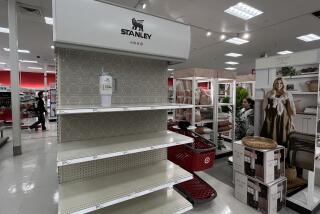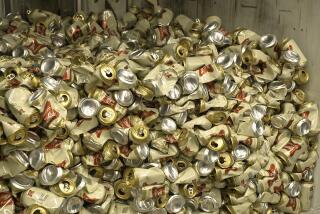Lamenting Decline in Billy Beer Popularity
- Share via
Question: What is the value of 36 Billy Beer cans (empty)?--F.C.
Answer:A few years ago, it appears that a mythology of sorts grew up around the Billy Beer brand, named after former President Jimmy Carter’s colorful brother. We saw--and occasionally still spot--this particular brand advertised at sky-high, double- and triple-digit prices in collectible want ads.
At the time, we checked with a number of knowledgeable beer-can collectors who contended that the Billy Beer label simply shouldn’t command more than a few bucks a can, if that. In short, they asserted that the spurt in advertised prices was started by a couple of California collectors, among others, who thought they had a lock on the Billy Beer can supply. This turned out not to be the case, because there were literally thousands of cans of this brand on the market at the time.
False Impression
Having stayed in touch with the beer-can collecting market, we would have to say that’s still the case today. Yet, we still get a number of letters from collectors who think that their Billy Beer cans are more valuable than IBM common stock.
Regarding your reference to the cans being empty, there’s some difference of opinion among collectors on whether this makes any real difference in appraising the can. Most say no.
Much of the action in this field appears to have gained momentum in the 1970s, and now, we are told, there are thousands of beer-can collectors in this country and abroad.
Of course, collecting beer cans has to be a relatively new form of collectible activity because the beer can itself didn’t appear on the scene until the mid-1930s. Before that (following the end of Prohibition in December, 1933), beer was either shipped in kegs or marketed in returnable bottles (which themselves are highly collectible).
Who innovated the use of the beer can? History is a little fuzzy on this event.
Some veteran collectors point to a brand called Krueger’s Finest Beer as the first brewer to market beer in cans in 1935. Others look to the first patent on a beer can issued to the American Can Co. in September, 1934. In any case, it does appear that the Gotfried Krueger Brewing Co. of Newark, N.J., was the first brewer to use the can. Following that innovation, it appears that Pabst was the first major company to market its brew in cans.
The 12-ounce Krueger can showed what appears to be a waiter or busboy serving two glasses of the brew on a tray. Krueger’s also marketed a canned ale in 1935. These first cans required separate openers that, we’re told, also are quite popular with collectors.
The rest, as we like to say, is history. Canned beer sales took off as a number of manufacturers got into the act. Naturally, some of these earliest cans now change hands for hundreds of dollars each.
As the transition was being made from the earliest cans to the pull-tab and ring-type opening devices, the cone-top can also briefly surfaced in the 1930s and 1940s, usually utilizing a screw-type cap. This can too has become sought after by collectors.
Determining Value
What makes a beer can valuable besides age? A manufacturer may have brought a can to market to mark a particular event. Or, some connection with history can add to its price tag. For example, thousands of camouflaged beer cans were produced during World War II for GIs at the front; today they are considered quite a find by collectors.
Aside from nationally marketed brands, new collectors are advised to keep an eye out for as many local brands as possible. That goes for both at home and when you’re traveling abroad, veteran beer-can collectors say. It’s the hard-to-find local brands, they say, that can give your growing collection some dimension.
Signs of Rust
As for condition, older cans may show signs of rust or may exhibit dents. If the can is judged to have value, serious collectors will attempt to rub out the rust or knock out the dents, taking care not to puncture the can.
And by researching the original can through the manufacturer’s archives, through beer-can-collecting organizations or by reading books on the subject at your local library, it’s possible to retouch a can by matching paint to the original manufacturer’s colors. Unless you make this effort, a beat-up beer can has little value on the collectible market.
For interested collectors, there is a national organization with local units: Beer Can Collectors of America, 747 Merus Court, Fenton, Mo. 63026.
And F.C., thanks for writing all the way from Hamilton, Mont. Sorry we couldn’t be more encouraging about Billy Beer, but, as a collectible, beer cans are among the most colorful and interesting.
Ronald L. Soble cannot answer mail personally but will respond in this column to questions of general interest about collectibles. Do not telephone. Write to Your Collectibles, You section, The Times, Times Mirror Square, Los Angeles 90053.


